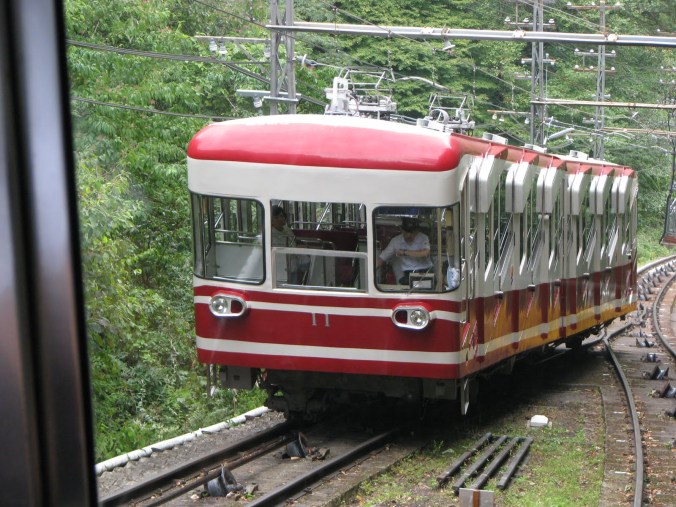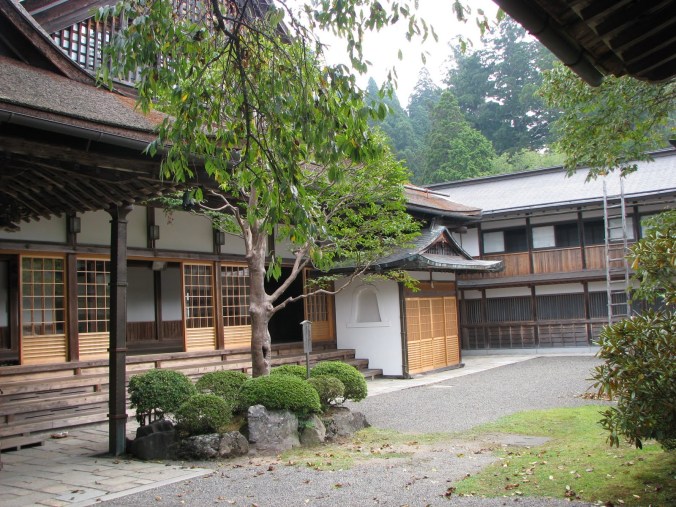I kept a notebook of notes to keep the activities from day to day straight so I could enter everything on my blog. The day we traveled to Koya-san was September 11, 2009. My first entry that day was “God Bless America”.
We checked out of the hotel and had a quick breakfast of coffee and breads at the bakery. While walking to the train station, we stopped at a drug store because David had a nasty blister on his foot and we wanted to get some anti-bacterial ointment. We started out by looking for it on our own. Again, it is impossible to know what you are purchasing….is that little tube in the box anti-bacterial cream, diaper rash ointment or hemorrhoid cream? Trying to be ever so helpful, a clerk asked what we needed…he spoke no English but had a card that translated common health issues from English to Japanese. We pointed to the “I have a cut” and tried to explain that we wanted the cream. No one understood. We were about to give up as we had a train to catch when one of the clerks indicated for us to wait. He then took off across the street, to another pharmacy. He came back with a large English/Japanese dictionary and were able to show him what we needed. We were standing in front of the anti-bacterial ointment the whole time! Just sharing this as it is just one of many examples of the communication issues that we encountered!
Our destination for this day was Koya-san. A small town in the mountaneous Kii-Hanto (Kii-Peninsula) region. The major attraction here is the monastic complex (there are about 80 temples) which is the headquarter for the Shingon school of Esoteric Buddhism. Yes, we were traveling to get enlightened! No, seriously, we heard that you could spend a night at one of the temples and thought that would be an real amazing experience. So, we headed to Koya-san. It was a long day of traveling.
At 9:30, we hopped the train from Nara to Hashimoto. In Hashi moto we changed trains and train lines (we were traveling Japan Rail line) to Nankai line. This train we rode on until we reached Gokurakuhashi, which took us up into the mountains. Finally, we took a funicular, about a five minute ride, up the steepest part of the mountain and arrived at 2:00 in the afternoon. From the train station, we caught the bus to the downtown area where information was.
moto we changed trains and train lines (we were traveling Japan Rail line) to Nankai line. This train we rode on until we reached Gokurakuhashi, which took us up into the mountains. Finally, we took a funicular, about a five minute ride, up the steepest part of the mountain and arrived at 2:00 in the afternoon. From the train station, we caught the bus to the downtown area where information was.
A young priest, Kobo Daishi travelled to China and two years later, in 816, he returned to Japan and founded the Shingon school of Esoteric Buddhism. He is considered one of Japan’s most famous religious figures. The followers of Shingon believe that Kobo Daishi is not dead but meditating in his tomb in Koya-san’s famous cemetery, Oku-no-in. It is believed that Kobo Daishi is waiting for the arrival of Miroku, the future Buddist. When Miroku arrives, it is thought that only Kobo Daishi will be able to interpret Miroku’s message for humanity.
At the information office, we made our reservation for the night at the Shojoshinin Temple. The temples all have a fix price. It was about $200, which included dinner and breakfast. It was a short walk through town to get to temple. The town has really adapted itself to tourist! Many stores were souvenir shops or restaurants…which all closed around 6:00. Koya-san isn’t a place to go for a wild night on the town!
 We stayed at the Shojoshinin Temple. We were met at the temple by one of the four monks that lived there. He explained about the gates closing and what door would be open to get in after 9:00 PM. The bath was drawn at 4:00 and was available until 7:00. Dinner was served at 5:30 PM and we were to meet in the lobby area where we would be shown to the dining room. Breakfast was after the 6:00 AM prayer service that we were expected to attend. After our orientation, the monk showed us to our room. It was one of 9 rooms available at this temple for tourist to spend the night. It was a lovely traditional room on the third floor that overlooked a serene Japanese garden.
We stayed at the Shojoshinin Temple. We were met at the temple by one of the four monks that lived there. He explained about the gates closing and what door would be open to get in after 9:00 PM. The bath was drawn at 4:00 and was available until 7:00. Dinner was served at 5:30 PM and we were to meet in the lobby area where we would be shown to the dining room. Breakfast was after the 6:00 AM prayer service that we were expected to attend. After our orientation, the monk showed us to our room. It was one of 9 rooms available at this temple for tourist to spend the night. It was a lovely traditional room on the third floor that overlooked a serene Japanese garden.
After getting checked in, we walked to the the Oku-no-in Cemetery whic h was right next door. What an amazing place! For over 1,200 years, it has been the place to be laid to rest. Buddhist want to ensure that they are nearby when Miroku (the future Buddha) comes to earth. The walkways are lined with tall cedar trees and there are more than 100,000 graves. Some graves were extremely old and others were very new.
h was right next door. What an amazing place! For over 1,200 years, it has been the place to be laid to rest. Buddhist want to ensure that they are nearby when Miroku (the future Buddha) comes to earth. The walkways are lined with tall cedar trees and there are more than 100,000 graves. Some graves were extremely old and others were very new.
At the northeast end of the cemetery is the Toro-do (Lantern Hall). There were about 11,000 lanterns; two of which, it is believed, have been burning continuously for 900 years. Most of the lanterns were hanging from the ceiling in the main hall. It was really quite a sight but unfortunately, no pictures were allowed.
Would you believe, that I didn’t have my little book to be signed by the monks? So, while David patiently waited, I shuffled the mile back to our room to retrieve it. It was worth it though!
Wandering around the cemetery for the afternoon was a nice reprieve from the crowded cities that we had been in ever since arriving in Japan. After visiting the Lantern Hall, we made our way back to the temple and took our  bath. The Japanese bathing ritual is very different from ours. There is a large tub that is full of hot water. However, you don’t bathe in the tub, it is more to soak and relax in after you are clean. So, with a hand held shower hose, you get wet, lather with soap and rinse yourself off completely before getting in the tub. It is considered extremely rude to get soap in the tub as everyone in the family uses the same water to soak in. Very, very different from the western way, but also, very relaxing.
bath. The Japanese bathing ritual is very different from ours. There is a large tub that is full of hot water. However, you don’t bathe in the tub, it is more to soak and relax in after you are clean. So, with a hand held shower hose, you get wet, lather with soap and rinse yourself off completely before getting in the tub. It is considered extremely rude to get soap in the tub as everyone in the family uses the same water to soak in. Very, very different from the western way, but also, very relaxing.
Dinner was served promptly at 5:30 in a long hall with s creen dividers between each seating area for some privacy. The tables were low to the floor and we sat on pillows. I truly enjoyed this meal as the Buddhist are vegetarians. So, for dinner and breakfast, I was able to let my guard down and not worry if there was any meat or poultry in the recipes. The Japanese meals are an art form the way they are served. Small servings in a variety of small bowls. Some had covers and other bowls didn’t. The menu was sticky rice (David’s favorite), tofu with soy sauce and wasabi, veggies, 2 types of soup, tempura vegetables, pickles, beans, edamame and squash, fruit and green tea!
creen dividers between each seating area for some privacy. The tables were low to the floor and we sat on pillows. I truly enjoyed this meal as the Buddhist are vegetarians. So, for dinner and breakfast, I was able to let my guard down and not worry if there was any meat or poultry in the recipes. The Japanese meals are an art form the way they are served. Small servings in a variety of small bowls. Some had covers and other bowls didn’t. The menu was sticky rice (David’s favorite), tofu with soy sauce and wasabi, veggies, 2 types of soup, tempura vegetables, pickles, beans, edamame and squash, fruit and green tea!
We went for a walk after dinner looking for batteries for my camera. Like I said earlier, the town rolls up the sidewalks around 6:00. We were lucky to find one store open and they had batteries! We were back in our room at 7:00 and in bed early, as we had to be up and ready for 6:00 AM prayers. We walked 8.5 miles, 17,522 steps.
We got up at 5:30. The bell rang to assemble for prayer. The prayer hall was a long room and we were instructed to sit on the bench against the back wall. The monks sat on the floor in the temple and had a small table in front of them with their prayer book. The alter had a Buddha statue in what  appeared to be gold. I honestly don’t remember much of the room, just lots of reds and gold, dim lighting, candles and incense burning. They chanted their prayers for a half hour. Then we were led to the dining hall for our breakfast. We had fried tofu, rice, miso soup, a green spinach type vegetable with crushed sesame seeds and green tea. Again, the presentation was artfully done.
appeared to be gold. I honestly don’t remember much of the room, just lots of reds and gold, dim lighting, candles and incense burning. They chanted their prayers for a half hour. Then we were led to the dining hall for our breakfast. We had fried tofu, rice, miso soup, a green spinach type vegetable with crushed sesame seeds and green tea. Again, the presentation was artfully done.
By 8:30, we were getting the bus to head down the mountain and make our way to Hiroshima.